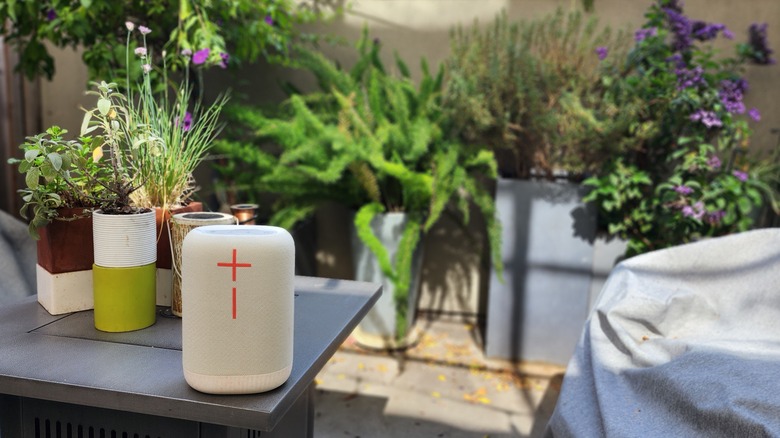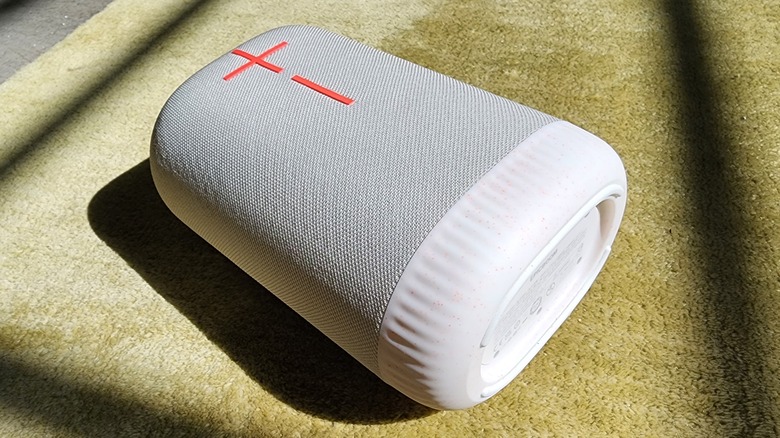Ultimate Ears Epicboom Review: Big Sound, Small Footprint
- Respectable audio quality
- Stylish, eco-conscious design
- IP67 weather-proof rating
- Custom, preset, and Adaptive EQ
- Four streaming playlist presets
- Limited options for connecting streaming services
- Does not include power adapter
We may receive a commission on purchases made from links.
It's probably fair to say that every music lover could use a Bluetooth speaker, but if you're going to have only one, how do you choose? Do you prioritize big, loud, gorgeous sound, in which case you're looking at a large, hefty item that doesn't travel very easily? Or how about an ultra-portable wireless speaker you can throw into a backpack but which doesn't impress anyone with its sound or volume? With its new Epicboom speaker, Ultimate Ears attempts to split the difference. It's a portable Bluetooth speaker with enough heft in its bass and power to its sound to be suitable for everyday music listening.
It has easy hardware controls for recalling saved playlists and boosting the sound and an app for customizable EQ and other settings. The latest in Ultimate Ears's Bluetooth speaker line also takes a step forward in the long journey toward achieving a closed-loop, circular economy. It uses post-consumer recycled material, and the speaker and battery are made for eventual recycling.
Yet all that doesn't mean much if it doesn't sound as epic as its name implies. Ultimate Ears provided a sample of the Epicboom for this review.
Setting up
Epicboom's setup requires little effort. The box comes with the speaker itself and a single USB-C to USB-C cable for charging. You have to have your own power supply for plugging in the charging cable, which goes in under the protective "weather door" in the back. When charging, three white LEDs above the speaker's volume buttons show the charging level. The recommended and free Boom companion app (for iOS and Android) also shows the charging level in 10% increments.
You can power on and start using the Epicboom while it's charging. The Boom app gives you access to all the controls like power and volume, or you can just use the speaker's hardware buttons.
It's a routine process to pair your Bluetooth devices to the Epicboom. After connecting a phone to the Epicboom and later turning off the speaker, it automatically pairs with the phone the next time it is turned on — this speaker can "remember" the last eight devices it connects to.
The Boom app can also connect to a limited amount of music streaming services so you can save and launch some of your playlists from the speaker's "Magic Button." These are limited to Amazon Music, Spotify (Android only), and Apple Music (iOS only).
App and hardware controls
Once you connect a streaming service through the app settings' One Touch To Your Playlist option, you can then select items for the four presets triggered from the speaker's Magic Button (the one with the play/pause icon). For example, with Spotify connected, the user can assign playlists, albums, or podcasts to the Magic Button's presets with the Boom app.
To play and cycle through the presets, you press and hold the Magic Button and press and hold it again to play the next preset in the order. With a quick press, the Magic Buttons pause or play the audio as you'd expect, and with a double press, it skips to the next track.
All the major controls are available from the app, as well as hardware buttons: power, volume up/down, and something called the Outdoor Boost button (signified by a tree icon). Outdoor Boost adds a modest 1dB of volume to the output according to Ultimate Ears.
That isn't a lot, but there's something else going on with how Outdoor Boost changes the sound profile. It adds some airiness and spaciousness to the sound, and some mid-frequency punch to the bass tones. Whether indoors or outdoors, the Outdoor Boost can sound preferable, but it really just depends on the specific music playing. Sometimes with music that's already very bass-heavy, like different styles of EDM or hip-hop, the Outdoor Boost can sound a little muddy.
If the Outdoor Boost's bass kick doesn't sound right, it's easy enough to turn to the app's EQ settings.
Custom EQ settings and Adaptive EQ
Some wireless speakers have no EQ or limited EQ options, so it's nice that Ultimate Ears graces the Epicboom with preset and custom settings for its 5-band EQ, available within the Boom app. The five preset settings include Bass Boost, Game/Cinema, Deep Relaxation (which has very reduced treble), and Podcast/Vocal (with an emphasis on mid-range and bass rolled-off).
There's also a flat EQ setting, which you can listen to or use to create your own EQ settings. Just drag some of the five EQ sliders up or down to dial in a setting, and then type in a new name to save your custom EQ settings in the preset list.
The Boom app also lets you toggle on or off the Adaptive EQ feature. According to Ultimate Ears, the Adaptive EQ is a smart EQ that automatically balances the Epicboom's sound to account for its environment and surroundings. That would imply that the Epicboom has at least one internal microphone it uses to measure the reflections of its sounds coming back off of nearby walls, ceilings, objects, etc. and accordingly makes adjustments to its EQ, possibly with the aid of machine learning algorithms.
However, that's just the implication. Ultimate Ears gives no further indication. In practice, with the Epicboom playing about equally with the Adaptive EQ on and off, there was not much noticeable difference either way. Certainly, the EQ presets and user-made EQ settings made much more of a noticeable difference in the environments where the Epicboom was tested: mainly high-ceilinged, large indoor rooms and outdoor spaces.
Purposeful design: style, eco-friendliness, and weatherproofing
When considering Bluetooth speakers, discerning parties will find no shortage of homogeneity when it comes to their design. Nondescript and undistinguished black boxes abound. Even new bits of flare like multicolored LEDs quickly become commoditized trends. The Epicboom is Ultimate Ears' latest in its Boom series that at least tries to stand out with some panache of its own. Large, vibrantly colored volume buttons contrast with the main color on both the Cotton White Epicboom tested here and the Charcoal Black version. And flecks of those trim colors are interspersed at the base of the unit as well.
Subjectively speaking, the Epicboom's design looks quite striking, especially for the Cotton White model with orange trim, worthy of sitting out to complement a room's decor even when not in use. Ultimate Ears also makes an effort toward environmental responsibility as well. The company claims a minimum of 59% of Epicboom's plastic is certified post-consumer recycled, while the textured polyester fabric that wraps the speaker's enclosure is 100% recycled. Portions of the speaker also can be recycled if you find the right facility, and you can remove the battery for recycling and ostensibly, replacement.
Not that you should have to consign the Epicboom to e-waste management anytime soon. Ultimate Ears has built it to last, with an IP67 rating to protect it from the ingress of dust and a high degree of water resistance up to full water immersion for 30 minutes. It actually floats in water and is said to be drop-safe from a height of three feet.
In use evaluation
To help avoid such drops, Ultimate Ears includes a strong nylon strap for carrying the Epicboom or for hanging it. At 4.4 pounds, the speaker is heavier than it looks at first, so you'll need something sturdier than, say, magnetic hooks from which to hang it. Its weight, as well as its dimensions of 9.4 x 6.3 x 4.6 inches, mean that the Epicboom is not the kind of Bluetooth device you throw into a carry-on to go visit the grandparents who have no good stereo equipment.
However, that size and weight are trade-offs for the internal workings that make the Epicboom more powerful than its super-portable alternatives. It peaks at an output of 95dB stemming from a 4.6-inch woofer and two mid-high frequency 1.7-inch transducers. They are positioned in a way intended to transmit audio in 360 degrees so the sound translates no matter where you stand around the speaker.
In practice, the 360-degree sound held mostly true, though it sounded like it slightly favored the head-on directionality. Its output power, though, means that owners can rely on the Epicboom for everyday listening if they don't feel like firing up their main speakers. And it's fantastic for carrying around from room to room, to bring to the garage while doing chores, or to take outside while catching some sun. When fully charged, it can basically go all day. The 17-hour advertised battery life applies to a volume level of 45%. In testing, it lasted about 16 hours playing at an average of around 60% before a spoken-word audio alert played saying the battery level was low.
Sound quality comparison
Not only is the Epicboom loud enough to fill up a large living room or to overpower the noise of an exercise machine, but its audio quality does the trick as well. If prioritizing only for sound quality and/or low-end thump, a great dedicated stereo system or home theater subwoofer system would still be the preference, but the Epicboom satisfyingly reproduced the full-frequency spectrum for the many genres of music evaluated: a mixture of electronic dance styles, hip-hop, indie rock, pop, and orchestral music.
It balances the frequency ranges quite well. There are no harsh or shrill highs. And while the low-end will not blow away any lover of trap or dubstep music with its 4.6-inch woofer, the important thing is that the bass sounds smooth and accurate, and plays in proportion to the rest of the sound, without either overpowering or being hidden within the mix. Also key: You do not get distortion when cranking up the volume to maximum levels.
Comparing the Epicboom directly with the popular Bose SoundLink Revolve+ II — a portable Bluetooth speaker about half the size and weight of the Epicboom but with a similar price — was interesting. The pristine clarity of the Bose sound profile makes it one of the very best in the large Bluetooth speaker market. While the Bose SoundLink's audio quality still edged out the Epicboom, it's a close comparison, and the Epicboom has a huger sound that can spread out and fill large spaces better. The Epicboom's customization for EQ curves and Outdoor Boost also make it versatile for dialing in the sound you want.
Ultimate Ears Epicboom verdict
The $349 Epicboom falls between Ultimate Ears' much larger $449 Hyperboom and the smaller/less powerful $199 Megaboom 3. It also occupies a less crowded mid-range space in the Bluetooth world. It's portable but not puny. It has respectable audio power but it won't break your back lugging it from the parking lot to the picnic table.
While the price tag is not for the bargain basement, it's also not outrageously priced considering the aforementioned SoundLink Revolve+ II costs $329. The Epicboom also costs $100 less than the comparable Sonos Move 2, which is a similar size but has a larger battery and extra features like Wi-Fi support.
When you need a well-rounded Bluetooth speaker that fits many scenarios, the Epicboom makes a great candidate. It's pretty enough to be a fixture in your home, but durable enough to work outside in all weather conditions. It sounds good enough and loud enough for regular everyday use, but it's small enough to carry around and take on road trips. It has an app that offers many EQ options and streaming service connections but leaves out some technological bells and whistles like Wi-Fi and voice control to keep the price reasonable. Ultimate Ears' nod to recycled materials and recyclability doesn't hurt either.








